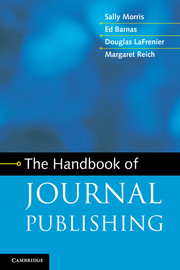Book contents
- Frontmatter
- Contents
- Preface and acknowledgments
- 1 Introduction to journals
- 2 Managing journals
- 3 Editing
- 4 The production process
- 5 Journal metrics
- 6 Marketing and sales
- 7 Fulfillment
- 8 Journal finances
- 9 Subsidiary income
- 10 Contract publishing
- 11 Copyright and other legal aspects
- 12 Ethical issues
- 13 The future of scholarly communication
- Appendix 1 Glossary
- Appendix 2 Resources
- Appendix 3 Vendors
- Index
- References
12 - Ethical issues
Published online by Cambridge University Press: 05 March 2013
- Frontmatter
- Contents
- Preface and acknowledgments
- 1 Introduction to journals
- 2 Managing journals
- 3 Editing
- 4 The production process
- 5 Journal metrics
- 6 Marketing and sales
- 7 Fulfillment
- 8 Journal finances
- 9 Subsidiary income
- 10 Contract publishing
- 11 Copyright and other legal aspects
- 12 Ethical issues
- 13 The future of scholarly communication
- Appendix 1 Glossary
- Appendix 2 Resources
- Appendix 3 Vendors
- Index
- References
Summary
The discussion of ethics in scholarly publishing has become more common in recent years. One could argue that this is due to an increasing amount of unethical behavior by authors, who are under ever more pressure to publish often and in high-profile journals, and who may stretch or breach the boundaries of what is ethical in order to do so. One could also argue that the use of technology to create a manuscript makes it easier to copy and paste published texts, or to tweak the information shown in a figure. But at the same time, this technology makes instances of unethical conduct easier to find, because, for example, it is easy to compare two documents electronically, to open an electronic figure file to see how it was changed, or to search for text online to see if it has been copied from another source. So one could equally argue that authors are not more dishonest than they used to be, but that ethical issues are more easily, and therefore more frequently, found. More than likely, the apparent increase in cases of ethical misconduct is a combination of all of the above.
There is a spectrum of ethical issues, and some can be considered more serious than others, as will be clear throughout this chapter. They range from unintentional sloppiness, through intentional pushing of the boundaries and “researchers behaving badly,” to the kind of behavior that negates published research, destroys careers, and tarnishes the research enterprise.
- Type
- Chapter
- Information
- The Handbook of Journal Publishing , pp. 358 - 379Publisher: Cambridge University PressPrint publication year: 2013



